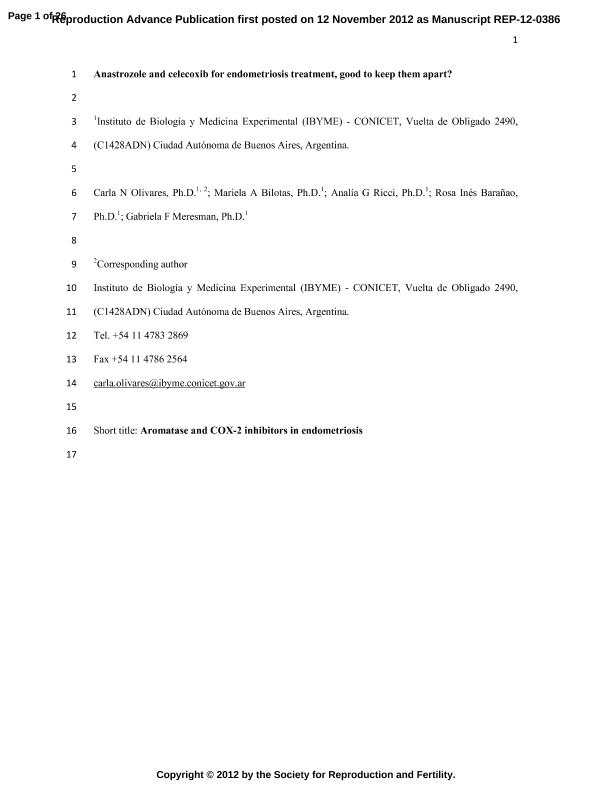Artículo
Anastrozole and celecoxib for endometriosis treatment, good to keep them apart?
Olivares, Carla Noemi ; Bilotas, Mariela Andrea
; Bilotas, Mariela Andrea ; Ricci, Analía Gabriela
; Ricci, Analía Gabriela ; Barañao, Rosa Ines
; Barañao, Rosa Ines ; Meresman, Gabriela Fabiana
; Meresman, Gabriela Fabiana
 ; Bilotas, Mariela Andrea
; Bilotas, Mariela Andrea ; Ricci, Analía Gabriela
; Ricci, Analía Gabriela ; Barañao, Rosa Ines
; Barañao, Rosa Ines ; Meresman, Gabriela Fabiana
; Meresman, Gabriela Fabiana
Fecha de publicación:
14/01/2013
Editorial:
Bioscientifica
Revista:
Reproduction
ISSN:
1470-1626
e-ISSN:
1741-7899
Idioma:
Inglés
Tipo de recurso:
Artículo publicado
Clasificación temática:
Resumen
Endometriosis is a benign gynecological disease. Cyclooxygenase-2 (COX-2) and aromatase proteins have been shown to be overexpressed in eutopic endometrium from women suffering from this disease compared to disease-free women. Furthermore, inhibition of these molecules individually was demonstrated to have antiproliferative and proapoptotic effects both in vitro and in vivo in several models. In this study, the effect of combining celecoxib, a selective COX-2 inhibitor, and anastrozole, an aromatase inhibitor, on the implantation and growth of endometriotic like lesions in a murine model of endometriosis was evaluated. Endometriosis was surgically induced in female BALB/c mice. After 28 days of treatment with celecoxib, anastrozole, or their combination, animals were killed and lesions were counted, measured, excised, and fixed. Immunohistochemistry for proliferating cell nuclear antigen and CD34 was performed for assessment of cell proliferation and vascularization. TUNEL technique was performed for apoptosis evaluation. Celecoxib was the only treatment to significantly reduce the number of lesions established per mouse, their size and vascularized area. In addition, cell proliferation was significantly diminished and apoptosis was significantly enhanced by both individual treatments. When the therapies were combined, they reversed their effects. These results confirm that celecoxib and anastrozole separately decrease endometriotic growth, but when combined they might have antagonizing effects.
Palabras clave:
Endometriosis
,
Cox-2
,
Aromatase
,
Mice, Inbred Balb C
Archivos asociados
Licencia
Identificadores
Colecciones
Articulos(IBYME)
Articulos de INST.DE BIOLOGIA Y MEDICINA EXPERIMENTAL (I)
Articulos de INST.DE BIOLOGIA Y MEDICINA EXPERIMENTAL (I)
Citación
Olivares, Carla Noemi; Bilotas, Mariela Andrea; Ricci, Analía Gabriela; Barañao, Rosa Ines; Meresman, Gabriela Fabiana; Anastrozole and celecoxib for endometriosis treatment, good to keep them apart?; Bioscientifica; Reproduction; 145; 2; 14-1-2013; 119-126
Compartir
Altmétricas



